Choosing a construction stapler

The construction stapler is a simple, convenient and practical tool. Charged with staples, nails or studs. With its help, 2 materials are fixed to each other without much physical effort. In the article we will tell you where these tools are used, what types there are, and how to choose them correctly.

Description and device
Description and device Construction (furniture) stapler is also called staple gun, staple gun, nailer, taker. It serves for adhesion of different materials: wood, chipboard, plywood, leather, insulation, cellophane. Types of staplers are not similar to each other, they work due to different energy potential, fasten with staples or nails, contain many differences.


But there are some unifying points in how any of these tools work:
- a device of any kind can be with a plastic or metal case;
- percussion mechanism contains a striker and a spring (except for the pneumatic version);
- when fired, any model absorbs;
- each tool is equipped with a safety guard against accidental triggering;
- all staplers are equipped with a mechanism with staples or nails;
- the device provides the entry of the staple with the subsequent bend;
- it is possible to control the accuracy of the shot;
- with the help of the regulator, the equipment is adjusted to work with surfaces of varying degrees of hardness.

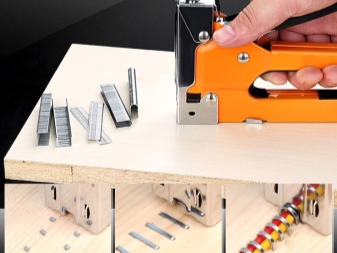


The furniture stapler works as follows:
- manual and electric models push out the fastener using a compressed spring; in a pneumatic product, a piston plays the role of a spring, supplying the fasteners using compressed air;
- the action of the taker occurs with the use of electricity or mechanically;
- after pressing the trigger, a spring (piston) enters into action, which transfers the force to the striker;
- the striking element, in turn, drives the bracket into the surface.


Before starting work, the percussion mechanism should be adjusted to the type of material to be fastened.
Where is it used?
Staple guns are professional (industrial) and household. They are used in production, where there is a need to connect materials with staples (nails), and at home. The device replaces a conventional hammer, only works with a higher performance. Most often, the stapler is used in the furniture and woodworking industries. The device is easy to hold in one hand. A lot of work is done with the help of takers:
- the device is used for upholstery and upholstery of furniture with fabric or leather;
- during the installation of a warm floor, anchor brackets are used to fix the pipes;
- window glazing beads are attached;
- door trims are installed;
- film, roofing material, heaters and carpets are mounted;
- plastic, plywood, chipboard, MDF, cardboard are attached to wood and other materials;
- with the help of a stapler, wires and cables are laid;
- pallets are collected;
- tackers are used for facing works.




The widespread use of staples is due to their advantage over nails in the case where the girth of a fixing element, such as a cable, is required.
Types
Staplers are classified by the way they use energy, the mechanism that provokes the shot, by the type of consumable (staples, nails, universal), tasks and field of activity.
The main dividing feature is the type of energy that the equipment uses. In this segment, there are three types of staplers: mechanical, electrical, pneumatic.

Knowing the technical characteristics of each type, you can decide for which work this or that construction tool is more suitable.
Electrical
After pulling the trigger, the work of the stapler is performed by electrical energy - it can be supplied from the mains or from the battery. After firing, the trigger takes its previous position. Models on an electric drive can punch dense surfaces and are supplied with large brackets, up to 5 cm. Physical effort is spent at the same time.
Network electric staplers operate on a 220 W network. A plastic case, rubberized elements on the tacker handle, and double cable insulation protect from electric shocks.


An electrical appliance has many advantages.
- You can do a lot of work without actually getting tired. Network models are especially not limited in time.
- Thanks to the powerful spring, a large impact force occurs. This allows you to bond tight surfaces.
- Medium power equipment fires 20-30 rounds per minute. Thus, it is possible to work with high productivity.
- The tool is endowed with an adjustable impact force, taking into account the density of the surface.
- The stapler contains a safety device that prevents accidental shots.
- Electrical appliances are equipped with the function of firing double staples to enhance the fixation of materials.
- The equipment is equipped with pulse frequency control.
- The device contains the function of removing jammed staples from the work surface.


The disadvantages of electric staple tools include several factors.
- Network binding. During a power outage, work is stopped.
- Dependence on the cable. The working process can take place at a distance limited by the wire.
- High cost relative to mechanical products.

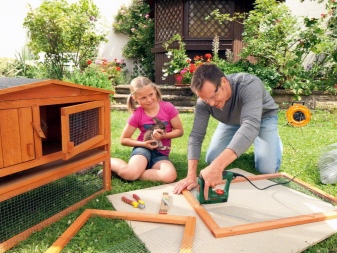
Types of electrical equipment include battery-powered models. Their main advantage is mobility, which allows you to work at any distance from the outlet, even on the street. The maximum size of the serviceable staples is 3 cm. On one battery charge, you can make up to 1000 shots at a frequency of 30 beats per minute.
The disadvantages of this equipment include weight, which can reach 2 kg, and an uncomfortable handle, since it contains a battery. The hand quickly gets tired from the heaviness and uncomfortable grip, productivity decreases.

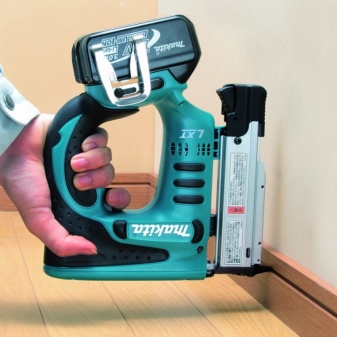
The cost of the standalone option exceeds the network model.
Mechanical
Devices that work by using the energy of our own muscles. They have low performance and are charged with a small number of staples. It takes a lot of effort to hold solid material together.

The main element of the impact unit is the spring. In mechanical staplers, it is of two types.
-
Twisted. The most budgetary version of hand tackers contains a coil spring. Its performance is rather low, the impact is weak, the resource is small, only 12 thousand clutches. The shot is accompanied by a strong recoil, which increases the force load on the worker's hand and leads to rapid fatigue. The adjustment screw installed on the body will help determine the presence of a coil spring in the tool.

- Leaf springs (plate). Such a model is more durable, its performance is higher than the previous version, it is endowed with a large impact force. The trigger is erected more easily, the noise is less, the recoil during the shot is soft, does not tire the hand. The service life of the plate product is designed for 75 thousand strokes. But the cost of equipment with a leaf spring is an order of magnitude higher than the model with a coil arrangement.

The advantages of mechanical devices over electrical options are few, but they are available:
- compactness;
- light weight;
- convenient use in everyday life;
- there is no connection to the availability of electricity, to the wire;
- the ability to work in confined spaces and difficult positions;
- the mechanism is so simple that it has nothing to break;
- budget cost.


In fairness, the disadvantages should be noted:
- the hand stapler does not pierce dense material;
- has low power;
- needs care and periodic lubrication, the regularity of which is noted in the instructions;
- unsuitable for large volumes of work.


For domestic use, the hand-held model is quite comfortable. Small size and weight allow you to hold it in one hand. By doing a small amount of work, you do not have time to get tired. Using a mechanical stapler, you can independently pull a sofa or chairs, fasten cellophane, leather, fabric, insulation with plywood or chipboard.
Hand equipment has uneven impact force, it is controlled by a switch. The availability of different power for mechanical models affects their cost. Some products are endowed with the possibility of an additional blow.


If the bracket is not fully fixed, an additional force impulse occurs.
Mechanical devices with high power belong to professional takers. They allow you to work for a long time with hard materials, withstand heavy loads. Their cost is close to electric models.
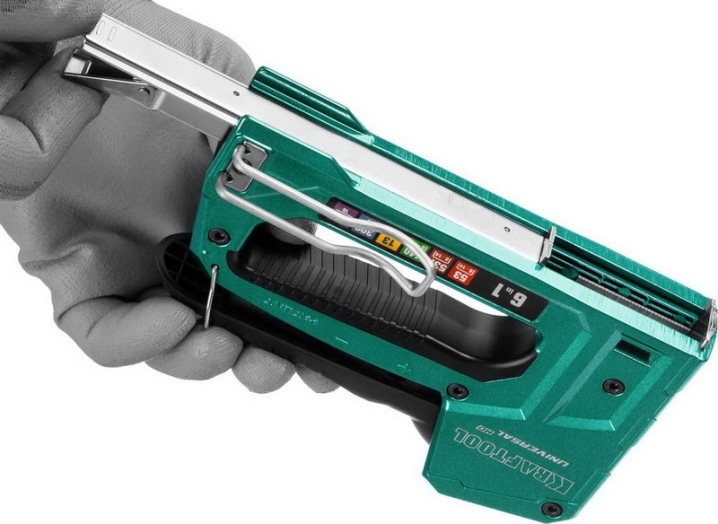
Pneumatic
The most powerful type of staple gun in professional equipment. It is used in large industries and small workshops. At home, pneumatic tools are inconvenient and irrational to use. The device needs to be cleaned periodically.
The staples or nails are fired using the energy of compressed air (without a spring). From a compressor or compressed air cylinder, the pneumatic valve supplies air to the pneumatic cylinder, which is the main operating unit. This process uses grid or battery power. The average working pressure is 4-8 bar, depending on the equipment model.

Pneumatic staplers are divided into stationary and manual. In the first case, the air flow is provided by pressing the pedal, in the second - by triggering. The device has many positive aspects.
- High power and impact force.
- The most productive speed of any stapler is 60 strokes per minute. Accordingly, greater productivity.
- Compact size and low weight of hand-held models (no more than 1 kg). This allows the hand not to get tired during prolonged work.
- The machine can handle staples up to 5 cm long and medium sized nails. Has a large capacious clip.
- The device is endowed with a blocking system.
- Protected against sinking staples.
- Designed for multiple blows and their adjustment.
- Contains several launch options.
- The design of the device is simple and durable.



The disadvantages of the equipment are also significant:
- the need for a compressor;
- a pneumatic hose brings inconvenience to the workflow, restricts movement;
- the device makes noise;
- not suitable for household service.

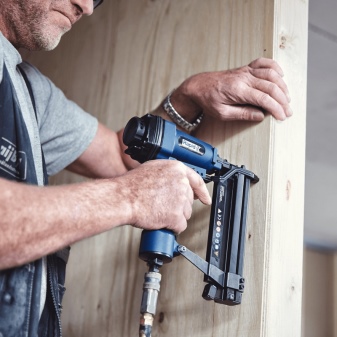
Hammerheads
This tool combines the capabilities of a stapler and a hammer. It has a long handle with a hammering mechanism at the end. In order for the bracket to enter the plane, you need to swing and hit it with a hammer taker. The shock from the spring will push the bracket towards the outlet and it will instantly enter the material.

The stapler body is made of carbon fiber to help keep the weight of the tool as low as possible. The ergonomic handle is covered with anti-slip material, which provides a comfortable grip during work and good work performance.
Loading of staples takes place in the striker. The device is endowed with automatic locking and the ability to remove inaccurately entered fasteners. The product weighs 800 g and is designed for half a million hits.
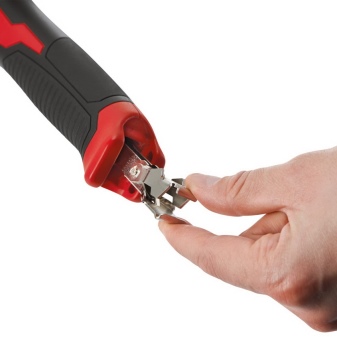

It is impossible to hit the target perfectly with a hammer tool, therefore they are used where the accuracy of the blow is not important, but the speed of work is appreciated. For example, for installing a floor, roofing felt or insulation.
Rating of the best models
On the domestic market, there are models of construction staplers from manufacturers from different countries. Equipment from Japan and Germany is especially famous for its quality. We have prepared a selection of the most popular staple gun models.
- Makita DST112Z. The stapler is equipped with a rechargeable battery. Time of continuous work is calculated for 3 hours.

-
Sturm ET4516. A budget electric tool filled with staples and nails. Differs in high-quality assembly. Fires 20 rounds per minute. But it has a relatively large weight - 1250 g.

-
Matrix Master. Popular hand held tacker, sturdy, durable, with steel body. Punches metal sheets easily.

-
Stayer 31501. Hand lever tool with iron body. Impact force is regulated. Comes with a case. But it has a lot of weight and tight pressing.

-
"Bison ZSP-2000". The Russian device is lightweight, the hand does not get tired during operation. Powered by a network.

- Bosch PTK 3.6 Li (0603968120). Good German battery model. Has a high rate of fire - 30 beats per minute, is loaded with staples 11.4 mm. Reliable, durable, with a 2-year warranty. You can work in a humid environment. Weighs 800 g.

-
Stanley Light Duty 6-TR150L. Popular lever stapler, mechanics. Ergonomic rubberized handle, steel body, power adjustment is present. Loaded with staples and nails.

How to choose?
The choice of a construction stapler is determined by the tasks to be faced. If the tool will be used at home, you will need a household model; for large-scale production work, you should choose a professional version, for a small workshop, a semi-professional tool is suitable. All three categories differ in the final price and the set of options. More durable professional equipment, it also contains the maximum number of functions.

When selecting a staple gun, there are other factors to consider.
- Better to purchase a model that can be assembled and disassembled. It has a special case, it is convenient to move with it for work on the road, transport the tool to the garage, to the dacha.
- You should pay attention to the size of the staples with which the equipment shoots., match them with the tasks expected from the stapler.
- The lever should be chosen ergonomic, with a comfortable grip and anti-slip coating. In addition, it is important to pay attention to its location, the closer it is to the body, the easier it is to do the job.
- The tool with a foldable handle is easy to transport. If the stapler does not have a safety catch, the folded position will help prevent accidental firing, otherwise the staples must be removed from the equipment every time you finish work.
- The electrical network model should be selected with a cable length of at least 5 meters, this size will facilitate movement in space.
- It should be noted the rate of fire of the tool, in the electric version, its components must have at least 30 beats per minute, with reduced indicators, labor productivity also decreases.
- When buying battery tackers, pay attention to the battery capacity and charging time. It is doubly more comfortable to have a spare power supply unit, then the work will not have to be interrupted while charging a dead energy carrier.
- The equipment is produced in 2 types of cases - plastic and metal. You need to decide for yourself what is more important - the weight of the model or the durability.
- A stapler with a fine tip on the working part will provide more precision hitting. A transparent store will allow you to control the number of available staples and not miss their replenishment.
- A mounting tacker for wood and other materials must be able to respond to the density of the surface. If the workflow is not adjusted with respect to the elements being fastened, you may find that the stapler bends the staples, or they do not fit tightly into the surface.
- It is a pleasure to discover the device as an option, with the function of double staple and additional impact.




When choosing a tool, it should be remembered that each attached feature is reflected in its final cost. If you rarely have to work with a staple gun and only at home, it is better to think about whether additional options are needed that you may not need to use.
How to use?
Before starting work, the tool should be replenished with staples. In a mechanical model, this happens as follows:
- using a fuse, they set a blocking against unexpected switching on;
- they open the lid of the store and find a section for staples, for some models the store slides out;
- remove the rod with the spring;
- the block of staples is inserted into the section, turning them over with their tips against the handle;
- then the rod with the spring is returned to its original place, pressing the staples;
- the store is closed, the fuse is released;
- fire several test shots.

Do the same with nails. Electric and pneumatic tools are filled in a similar way:
- the process begins with blocking the stapler;
- on the back of the equipment, find the mounting section and open it by pressing a button;
- pins (small nails) or a clip of staples are inserted into the grooves, pushing it in until a characteristic click appears;
- then close the lid, release the blockage, and fire test shots.
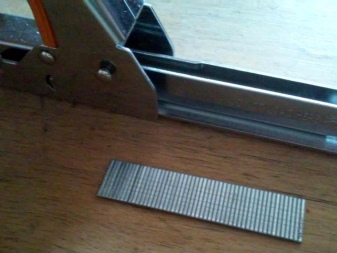

When the stapler is fully charged, start work. Carefully connect the two types of material that need to be fastened. The tool is firmly attached to the fixation point - and the trigger button or lever is pressed. After clicking, the taker is removed, and the quality of the fastening is checked.

If the bracket is perfectly positioned, then the density adjustment has been made correctly and the work can be continued.
It should be remembered that safety precautions must be observed when working with a stapler. It consists in the following points:
- do not point the instrument towards people or animals;
- in poor health, it is better not to start the work process;
- fixation of materials should be carried out with protective goggles and gloves, especially for industrial equipment;
- electrical appliances must be checked for serviceability before use.


Rational use of a stapler is possible only with the right choice of tool. It must fully meet the requirements of price and quality. For living conditions, you should not choose professional equipment - it will not only cost more, but also complicate simple repair operations carried out at home.













The comment was sent successfully.